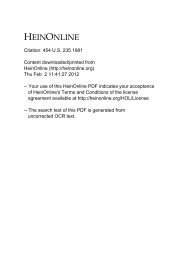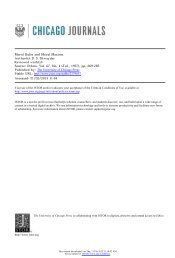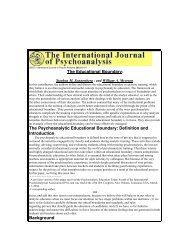Spring 2002 - The University of Texas at Austin
Spring 2002 - The University of Texas at Austin
Spring 2002 - The University of Texas at Austin
You also want an ePaper? Increase the reach of your titles
YUMPU automatically turns print PDFs into web optimized ePapers that Google loves.
the entire spectrum <strong>of</strong> new weapons<br />
and tactics made available by the revolution<br />
in military affairs; or whether<br />
to continue the force structure the<br />
United St<strong>at</strong>es has maintained since<br />
the rearmament following Pearl<br />
Harbor, which enables warfighting<br />
in two, major regional conflicts<br />
against hostile regional powers like<br />
Iraq or North Korea (the “B” list);<br />
or whether to change radically its<br />
defense posture to deal with new<br />
thre<strong>at</strong>s such as asymmetric <strong>at</strong>tacks<br />
from apparently st<strong>at</strong>eless challengers<br />
(like the Osama bin Laden network),<br />
humanitarian crises in stricken<br />
st<strong>at</strong>es (like Rwanda), and internecine<br />
violence in collapsing st<strong>at</strong>es<br />
(like Bosnia.) Advoc<strong>at</strong>es <strong>of</strong> the “A”<br />
list str<strong>at</strong>egy had to overcome the<br />
continental inertia <strong>of</strong> the military<br />
bureaucracy by exagger<strong>at</strong>ing the<br />
thre<strong>at</strong> from China, the only peer<br />
competitor with whom political rel<strong>at</strong>ions<br />
could possibly suggest imminent<br />
hostilities. “B” list advoc<strong>at</strong>es,<br />
mostly in the Pentagon and in<br />
Congress, had the successful precedents<br />
<strong>of</strong> World War II and the Gulf<br />
War to cite in fending <strong>of</strong>f efforts to<br />
scrap wh<strong>at</strong> has been an enormously<br />
successful str<strong>at</strong>egy even if it yielded<br />
a force structure vastly too expensive<br />
and unwieldy for the menaces it<br />
was now called upon to respond to.<br />
“C” list advoc<strong>at</strong>es sounded like boutique<br />
reformers whose radical ideas<br />
would leave the n<strong>at</strong>ion bereft <strong>of</strong><br />
defenses in the only conflicts th<strong>at</strong><br />
could truly prove mortal for her<br />
while chasing after conflicts in<br />
which the n<strong>at</strong>ional interest was only<br />
marginally implic<strong>at</strong>ed.<br />
A partial answer to this problem<br />
lies in transl<strong>at</strong>ing the separ<strong>at</strong>e lists<br />
into one another, much as the partial<br />
answer to the fundamental<br />
forces question in physics lay in seeing<br />
the weak nuclear force and electromagnetism<br />
as a single electroweak<br />
force. An “A/C” solution<br />
would use high technology —like<br />
shared missile defense, and shared<br />
intelligence and surveillance inform<strong>at</strong>ion<br />
— to forestall “A” list peers<br />
from becoming adversaries, and<br />
deploy reconfigured forces from<br />
P R O F ESSOR’S<br />
CHOICE<br />
MICHAEL HOWARD, <strong>The</strong> Invention<br />
<strong>of</strong> Peace (Yale, 2001)<br />
JOHN KEEGAN, <strong>The</strong> History <strong>of</strong><br />
Warfare (Knopf, 1993)<br />
MARTIN VAN CREVELD, <strong>The</strong> Rise<br />
and Decline <strong>of</strong> the N<strong>at</strong>ion-St<strong>at</strong>e<br />
(Cambridge, 1999)<br />
CHARLES L. BLACK, JR., A New<br />
Birth <strong>of</strong> Freedom (Yale, 1997)<br />
CZESLAW MILOSZ, New and Collected<br />
Poems 1931-2001 (Penguin,<br />
2001)<br />
HOMER, <strong>The</strong> Iliad (trans. Robert<br />
Fagles) (Viking, 1990)<br />
secure, defensible bases in coalition<br />
with American peers and local<br />
indigenous troops, to fight the 21st<br />
century wars <strong>of</strong> the “C” list. This<br />
would not necessarily enable the<br />
United St<strong>at</strong>es to maintain its twomajor-regional-conflicts<br />
capability,<br />
but it would hardly entirely do away<br />
with the force structure the United<br />
St<strong>at</strong>es currently maintains, because<br />
conventional ground forces are<br />
indispensable in termin<strong>at</strong>ing war by<br />
occupying territory. It was the<br />
imminent thre<strong>at</strong> <strong>of</strong> NATO ground<br />
troops in Kosovo, we should bear in<br />
mind, th<strong>at</strong> enabled the high-tech<br />
bombing str<strong>at</strong>egy to succeed and<br />
forced Milosevic to surrender.<br />
<strong>The</strong> September <strong>at</strong>tacks on New<br />
York and Washington should bring<br />
some clarity to this deb<strong>at</strong>e, as well as<br />
an historic opportunity to pursue<br />
intern<strong>at</strong>ional terrorism by means <strong>of</strong><br />
coalitional warfare. This opportunity<br />
allows the United St<strong>at</strong>es and her<br />
allies to pursue a form <strong>of</strong> war th<strong>at</strong><br />
could forestall the c<strong>at</strong>aclysmic conflicts<br />
among gre<strong>at</strong> powers th<strong>at</strong> modern<br />
technology makes possible.<br />
Viewed with this opportunity in<br />
mind, these <strong>at</strong>tacks can be understood<br />
as the first b<strong>at</strong>tle in a new war.<br />
<strong>The</strong> multin<strong>at</strong>ional mercenary terror<br />
network th<strong>at</strong> Osama bin Laden<br />
and others have assembled is a new<br />
and mut<strong>at</strong>ed organ <strong>of</strong> the market<br />
St<strong>at</strong>e, r<strong>at</strong>her like a malignant nongovernmental<br />
organiz<strong>at</strong>ion (NGO)<br />
or multin<strong>at</strong>ional corpor<strong>at</strong>ion. Like<br />
st<strong>at</strong>es, it has a standing army; it has<br />
a treasury and a consistent source<br />
<strong>of</strong> revenue; it has a permanent civil<br />
service; it has an intelligence collection<br />
and analysis cadre; it even runs<br />
a rudimentary welfare program for<br />
its fighters, and their rel<strong>at</strong>ives and<br />
associ<strong>at</strong>es. It has a recognizable hierarchy<br />
<strong>of</strong> <strong>of</strong>ficials; it makes alliances<br />
with other st<strong>at</strong>es; it promulg<strong>at</strong>es laws<br />
th<strong>at</strong> it enforces ruthlessly; it declares<br />
wars. Wh<strong>at</strong> it lacks is a contiguous<br />
territory. This network, <strong>of</strong> which<br />
al Qaeda is only a part, is not a geographical<br />
st<strong>at</strong>e. It is, however, a<br />
juridical entity nevertheless—a new<br />
kind <strong>of</strong> virtual st<strong>at</strong>e made possible<br />
by advances in intern<strong>at</strong>ional telecommunic<strong>at</strong>ions<br />
and transit, rapid<br />
comput<strong>at</strong>ion, and weapons <strong>of</strong> mass<br />
destruction. <strong>The</strong> virtual market<br />
st<strong>at</strong>e means th<strong>at</strong> our classical str<strong>at</strong>egies<br />
<strong>of</strong> deterrence based on retali<strong>at</strong>ion<br />
will have to be rethought. Th<strong>at</strong><br />
is another way <strong>of</strong> saying th<strong>at</strong> even<br />
when Afghanistan is conquered and<br />
pacified, the war against terrorism<br />
will go on.<br />
Deterrence, assured retali<strong>at</strong>ion,<br />
and overwhelming conventional<br />
force enabled victory for the coalition<br />
<strong>of</strong> parliamentary n<strong>at</strong>ion-st<strong>at</strong>es<br />
in the war th<strong>at</strong> began in 1914 and<br />
only finally ended with the Charter<br />
<strong>of</strong> Paris in 1990. <strong>The</strong>se capabilities<br />
cannot provide a similar victory <strong>at</strong><br />
present because wh<strong>at</strong> thre<strong>at</strong>ens the<br />
st<strong>at</strong>es <strong>of</strong> the world now is too easy to<br />
disguise and too hard to loc<strong>at</strong>e in<br />
any one place. We cannot deter an<br />
<strong>at</strong>tacker whose identity or loc<strong>at</strong>ion<br />
is unknown to us, and the very massiveness<br />
<strong>of</strong> our conventional forces<br />
makes it unlikely we will be challenged<br />
openly. As a consequence,<br />
we are just beginning to appreci<strong>at</strong>e<br />
the need for a shift from the sole<br />
reliance on target, thre<strong>at</strong>-based<br />
str<strong>at</strong>egies to defensive, vulnerability-based<br />
str<strong>at</strong>egies.<br />
Realizing th<strong>at</strong> we are fighting a<br />
virtual st<strong>at</strong>e and not just a st<strong>at</strong>eless<br />
<strong>Spring</strong> <strong>2002</strong> UTLAW 15

















